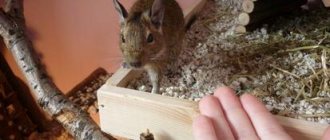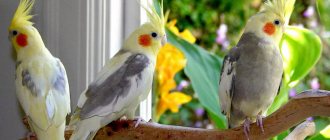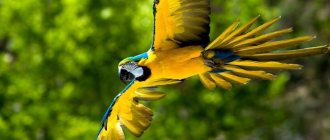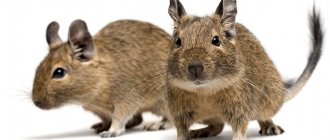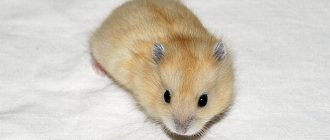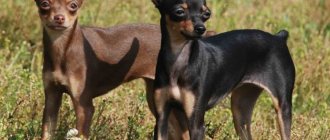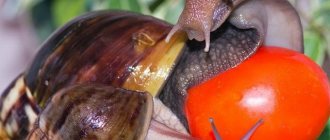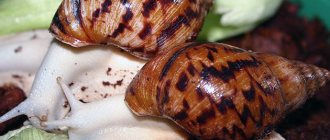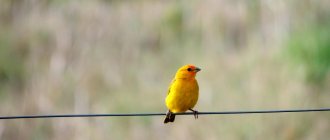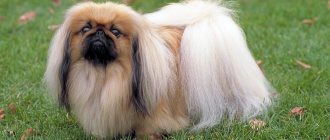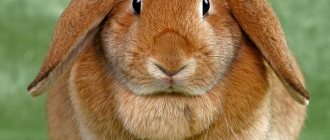Incredibly soft fur, large round eyes and neat ears, such a pet will bring comfort to the house and make its owners smile more often. A variety of colors will allow you to choose an animal that matches the tastes of even the most demanding breeders.
The chinchilla comes from the mountainous regions of South America; in their natural environment, the animals live in mountain crevices. Read on to learn how to create favorable conditions for furry rodents to live in an apartment.
Features of keeping chinchillas at home
Funny pets live in nature in the mountainous regions of South America. These are nocturnal animals that are most active in the evening and at night. The small rodent looks like a cross between a squirrel, a large mouse and a rabbit. Zoologists distinguish 2 types of chinchillas - mountain long-tailed and lowland short-tailed.
In the wild, animals live in small groups. They have excellent hearing and developed ears, large eyes and excellent night vision, as well as sensitive whiskers.
When keeping animals at home, you need to follow some rules:
- During the day, chinchillas mostly sleep or nap in their burrow. At night, the animal will rustle and rattle its feeder and other accessories in the cage. It is best to leave his house in another room where members of the household do not sleep.
- A chinchilla should not be allowed to roam around the apartment or house on its own. Especially if there are other animals living in the room. Dogs and cats actively hunt small animals.
- Chinchillas belong to the class of rodents, so they can damage many things in the house. They damage electrical wires, interior items, wallpaper, and upholstered furniture. It is advisable to walk your pet indoors under supervision, where there are no valuables or wires.
- All equipment in a chinchilla's cage must be well secured so that the animal does not get injured.
- Fur-bearing ornamental animals like to drink a lot of the time. They need to change the water in the drinking bowl every day. It is important to feed them on time and correctly, but in small amounts, no more than 2 tablespoons of food.
- Chinchillas love silence, so it is better to place your pet’s cage away from sources of loud sound, TV and tape recorder.
- A heat-loving rodent should be kept in a place with a stable air temperature. It should not be lower than +15 degrees, but not higher than +25-26. Direct sunlight should not fall on the pet's house.
This funny rodent grows up to 35 cm. Its fur is pleasant to the touch and thick, so its condition should be carefully monitored. Funny animals are non-conflict and peace-loving. They do not provoke each other into fights, do not scratch or bite. On command they can enter and exit the cage.
How many years do chinchillas live at home?
Chinchillas are a long-living rodent, with an average lifespan of 15 to 25 years. This period varies depending on the quality of care and living conditions of the animal. In order for a furry pet to live in captivity as long as possible, it is necessary:
- maintain optimal temperature conditions;
- ensure that the chinchilla’s menu is balanced;
- provide your pet with comfortable housing with maximum space for activity;
- carry out regular bathing in special sand;
- contact a veterinary clinic at the slightest suspicion of disease;
- protect the animal from stress and anxiety.
There is no average number of years for how long a chinchilla lives in an apartment; it all depends on the conditions that the owner creates for him.
Setting up an animal cage
You can buy a house for a chinchilla at a pet store or make it yourself from wood. It is important that the pet has enough free space, the ability to climb up/down, and rest quietly in a secluded hole. It is advisable to take a cage up to 100 cm high with several levels.
According to the standard, an animal cage must contain the following things:
- house for sleeping and relaxing;
- devices for jumping and running;
- salt or mineral stone for sharpening teeth;
- bath for bathing;
- litter tray with filler;
- feeder and drinking bowl.
Many breeders put tree branches in the cage. In spacious houses it is useful to install pipes in which rodents like to hide. They also love to spin the big wooden ring. Additional accessories include labyrinths, toys, hanging hammocks and ladders.
It is advisable to change the bedding in the cage every 3-4 days. Special mixtures are sold for rodents, but you cannot put pieces of paper, fabric, or sawdust into the animal’s house. These items can poison the chinchilla, injure the pet's body, cause irritation or allergies.
A chinchilla cage should have strong and strong bars that the animal cannot chew through. Breeders prefer metal options over plastic or wood. These are standard cages or display houses.
Flexible animals can squeeze between the bars, so the distance between them should be minimal - 1.5-2 cm. Internal and external objects in the cage should not be coated with varnish or paint.
Near a metal cage with bars there will always be dirt in the form of food debris or bedding. Glass display cases with a wooden frame and metal mesh are more practical and muffle noise from your pet. But over time, wood absorbs unpleasant odors, begins to crack, and swells from moisture.
Wooden display cages are more difficult to clean than iron display cages. It is better not to clutter a small cage with unnecessary accessories. The animal should move normally around its home, and not endure inconvenience and trip over strange objects.
You may be interested in: Yorkshire Terrier (York) description and character of the breed
Cell walls, trays, and rods cannot be cleaned with household chemicals. Once a month, you need to thoroughly clean the cage with plain water. All wood filler is removed.
Features of behavior
You need to be very careful when pairing your pet. If you decide to purchase a second animal, you need to gradually introduce them to each other:
- The animals must live next to each other for three days, the cages must be close to each other;
- Then prepare one common large cage, first carry out disinfection and general cleaning, change the floor covering;
- Leave new friends in a small cage for 3-4 hours;
- After this, introduce the first male into the new “apartment”, he will mark the entire territory;
- And the female is placed last.
By following these rules, you will avoid fights and injuries to your animals.
Changes in the animal's behavior may be associated with the period of estrus. Chinchillas come into heat regularly with an interval of 40-42 days. This period lasts from two to seven days. Hunting is characterized by a decrease in appetite and an increase in activity, while the genitals swell and become hyperemic. If you have a pair of chinchillas, mating will most likely occur at this time and further offspring are expected in 110-115 days. If you do not want offspring, it is better to remove the male during the period of estrus.
It should be noted that a characteristic feature of the chinchilla’s behavior is timidity, and the room with the rodent’s home should be left in silence. All manipulations with the animal should be carried out slowly, without sudden noises and movements, something new should be introduced gradually and stress should be reduced for the animal.
Is it possible to buy a chinchilla for a child?
Friendly and peace-loving chinchillas at first glance are ideal friends for children of different ages. They do not bite, do not show aggression, and their care can be entrusted to the small owner, but this is not so. Very young children of preschool age can harm animals. The latter interfere with sleep at night and sleep during the day. The child will not be interested in watching a sleeping and lethargic pet.
It is very easy to scare a chinchilla, so noisy children's games can traumatize the animal's psyche. Children love to play and carry pets, pull their tails or ears. Fluffy little rodents prefer peace and independent walks. They should not be given food from the table, as children like to do. Prohibited products can cause significant harm to the health of the animal and even cause its death.
Health diagnostics
What does a healthy chinchilla look like?
- The sole of the paws should be smooth and velvety. If your heels peel or bleed, change the padding and apply moisturizer.
- The teeth are bright orange and even. Light colored teeth indicate a calcium deficiency. If the animal is constantly drooling, its teeth have become too long.
- The nose is dry, without any discharge. If her nose is wet and she sneezes, she has a cold.
- Ears should be cold. Hot ears indicate that the noise is hot. Reduce the ambient temperature immediately! Peeling occurs due to prolonged bathing. Pigment spots on the ears (they look like freckles) are normal.
- Eyes are shiny and dry. There are no cloudy spots. If the eye is numb or swollen, rinse it with chlorhexidine. Perhaps a piece of filler or sand just got into it.
- Bald spots in fur are a sign of stress. Most likely, the chinchilla chews it out on its own. If the problem does not disappear after a month, have the scraping checked for mites.
- The weight of the shushi should not change dramatically. If you notice that Shusha has lost weight, start giving her mint regularly. The main culprit for weight loss is stress.
- The animal's urine is yellow and transparent. Blood may appear due to kidney problems.
- Boluses (droppings) should have an oblong shape and a smooth, slightly moist surface. A sharp decrease in the number of boluses indicates constipation. Temporarily switch the shusha to hay and water. If there is diarrhea, immediately give the animal an activated charcoal tablet. Mucus and blood in boluses are a reason for an urgent visit to the doctor.
- The genitals should be dry, without swelling or discharge. A ring of matted fur may form on the male's genitals. Usually the animal removes it on its own, but if swelling begins, help it.
Perform this inspection regularly to quickly respond to potential problems.
Taming a chinchilla
Each rodent has its own individual character. These are not dogs or cats that can learn many commands. It is not advisable to train chinchillas. These are independent and self-sufficient pets who love to sit in a person's arms and normally perceive touches, but can also be overly timid.
To establish communication with your pet, you should be patient. Frequent stroking and hugging can put the animal under prolonged stress, so in the first weeks of the animal’s adaptation to a new place, it is better to minimize human contact with it. He must gradually get used to the new environment.
Then you can gradually approach the cage and talk to the animal so that it gets used to the sounds. It won't be a big deal if you stick a couple of fingers into the cage. The chinchilla will sniff them and understand that she is not in any danger. Some adult chinchillas can get out and enter their cage on their own. You can lure them with your favorite treat and then gently pet them.
Which home is better?
The most common home for all rodents is a cage. Considering the size of the chinchillas, it should be no less than 50 cm in length and width and 70 cm in height. If possible, it is worth installing a larger and higher dwelling.
Experienced chinchilla breeders know that animals are rarely and reluctantly handled.
The point of keeping a chinchilla at home is the opportunity to observe the pet from the outside. A showcase is ideal for this. Such a house with closed walls will cause less hassle in the form of cleaning the room and will be able to successfully fit into the interior.
Having arranged a spacious dwelling on several floors for rodents, the owner will enjoy the zoo at home. Smart, inquisitive and dexterous chinchillas will always find something to please the observer.
How to care for a chinchilla's fur
Chinchillas simply love sand baths, so each of them should have a container in their cage for such entertainment. An ornamental pet, unlike dogs and cats, does not shed. It does not need to be bathed in water.
Such water treatments can even be harmful, since there are no sebaceous ducts on the rodent's skin. Their coat will get wet through, and the animal can quickly catch a cold. To maintain well-groomed and shiny thick fur, it is enough that the chinchilla takes sand baths.
To do this, place a container with fine river sand in the cage several times a week. After the procedure, the container is removed so that the sand does not scatter throughout the cage and does not fall into the feeder.
Content Basics
It should be remembered that the chinchilla spends all its time in a cage or display case. Due to the peculiarity of heat exchange of this animal, the temperature regime should be observed. The rodent's body temperature is 36 degrees. It is better to place the cage in a room with air conditioning; do not place it next to a radiator, otherwise during the heating season the animal may develop heatstroke, even leading to cardiac arrest.
At the same time, exclude direct air flows or drafts and direct exposure to sunlight. The habitat of your future pet should be in a cool (with a temperature of 18-20 degrees Celsius), shaded and, most importantly, quiet room.
But take care of your peace, the animal is nocturnal and there is no need to place a cage in the bedroom or in the room with the child, because night walks and games of a furry pet can disturb a restful sleep.
Cage equipment
The chinchilla will spend its entire life in your apartment in a cage and therefore the habitat should be spacious; it should be noted that cramped conditions are very depressing for the animal and this greatly shortens the life of the fluffy.
The minimum size of the cage is 60 by 60 cm, but the larger the display case, the better for the pet. Locks and latches must be strong and reliable so that an inquisitive animal cannot open them and escape from its home. Walking freely around the apartment is a great stress for the animal and is fraught with many dangers; any electrical wire can cause the death of the pet.
The main components of a cell:
- For chinchillas, you cannot place drinking bowls in the form of cups or bowls; the animal can turn them over and spill water. The drinking bowl must be made of high-quality plastic that does not allow water to pass through. If you purchase a ball drinker, make sure that no water accumulates under it, otherwise the animal will wet its fur. European drinking bowls are made of high-strength plastic, the spout is made of stainless steel, they do not leak and dispense the right amount of water strictly on demand. Experienced breeders recommend nipple drinkers. The drinkers are attached to the display case using suction cups or screws.
The drinking bowl must be disinfected regularly. It is good to do this with baking soda, then rinse with running water and pour over boiling water. Choose a drinking bowl that is convenient to attach and regularly remove and wash, as well as add fresh water. By the way, there are molds in which the top lid is removed.
- When choosing a feeder, pay attention to its stability, because active pets can turn over all the food and get injured during play. It is better to purchase a hanging feeder that is quite heavy in weight - ceramic or metal. It should be noted that plastic feeders are quickly chewed by rodents.
- Sennitsa is also a very necessary accessory. The hay does not scatter all over the display case and the animal takes only the required amount. Thanks to the closed design, the hay always remains fresh and with such a convenient element you can leave your pet for a couple of days without fear that he will be left without food. Attach the hay to the cage using bolts and washers.
- A hiding house allows the rodent to rest during the day and hide from danger. The material for production is only wood, because the animal can destroy its shelter. Attention, do not buy or make a shelter made of oak or resinous wood. A large amount of tannins causes constipation in chinchillas, and essential oils can cause poisoning.
- You need to install a bathing suit measuring 30 by 20 cm in the cage. Fill it with special sand, which is sold in a pet store; it can be of volcanic origin or contains talc. The sand needs to be changed regularly and cleaned of debris and feces.
- The cage should have wooden shelves and a wheel for games. Choose safe wood.
- To grind down constantly growing incisors and provide mineral premixes, equip the chinchilla's home with salt and limestones.
- It is better to purchase a tin pallet; it is advisable to choose a floor covering with low thermal conductivity; it is good to use sawdust or special wood filler.
Cleaning the cage should be done regularly, general cleaning should be done at least once a week, disinfection should preferably be carried out using an ultraviolet bactericidal lamp, drinking bowls and feeders should be washed with a soda solution and doused with boiling water.
Proper pet nutrition
A balanced, proper diet is the key to an active, happy and long life for a chinchilla (6-7 years). Some individuals reach up to 10 years of age. The animal must be fed the same food that it obtains in the wild. Regular pet stores sell many granular and grain mixtures designed specifically for feeding our furry rodents.
It includes not only a variety of cereals, but also pieces of dried fruit, seeds, and dried healthy herbs. More expensive foods are enriched with alfalfa and echinacea to support immunity, vegetable oils, vitamins and minerals.
In addition to the main food, there should always be fresh hay in the pet's cage to improve digestion. As treats, chinchillas are offered dried or fresh leaves of green lettuce, clover, sea buckthorn, spinach, plantain, nettle, and dandelion. Sometimes the animal is allowed to give a piece of dried carrot, apple, nut or raisin. A branch of birch, willow, linden, or apple tree is suitable for sharpening teeth.
The most dangerous thing is to feed your animal fresh fruits and vegetables, bread and other flour products, sweets, fatty pine nuts and almonds.
A chinchilla can become bored with a monotonous diet of dry food, so you need to purchase a new mixture every 4-5 months. Food should be available both day and night, as should clean water. In a year, a middle-aged chinchilla eats up to 6 kg of hay and 10 kg of combined food. It is better to collect and prepare hay yourself; it should not be wet, moldy, or with clods of earth. It should not contain poisonous herbs such as ferns, horsetails and buttercups.
It is advisable to include salt slime and chalk stone enriched with minerals in the menu. Feed is poured into the feeder once a day. This is enough to satisfy the animal. Some breeders introduce their own mixture of small lentils, corn, rolled oats and buckwheat into the animal’s diet. Additionally, flaxseed, enriched with healthy fatty acids, is added to the food.
As useful supplements, veterinarians recommend giving mallow leaves, willow leaves with buds, branches of hazel, aspen, poplar, several fresh viburnum berries, strawberries, raspberries, lingonberries, Jerusalem artichoke root or parsley. The animal will certainly appreciate pumpkin seeds, raw peanuts, as well as fresh leaves of good green tea.
Types and colors of chinchillas
Chinchillas for every taste
For a beginner in this business, it is important to know what types of chinchillas there are, how they differ and what is their peculiarity. This will help you choose a pet to your liking.
Due to a rather long selection process, animals with different coat colors appeared, but initially it was gray. The coat color was simple: white belly, gray head and back - it was classified as standard. Moreover, gray color includes all shades: from pale to rich graphite.
Chinchillas have a unique three-level color of each fur. All of them are pigmented along the entire length in shades of black (from the tip towards the root), white and gray. This determines such a valuable sheen of the fur coat. Silver, which is called “veil,” is considered the most beautiful.
Description of the breed standard:
- body length up to 37 cm;
- tail length up to 18 cm;
- rounded head;
- rounded ears up to 5 cm long;
- vibrissae up to 10 cm.
Chinchillas have 5 toes on their front paws and 4 on their hind paws. In nature, these animals hunt at night, so they have monocular, weak vision. The eyes are black, the pupil is elongated and vertical. Developed jaws with 20 teeth, of which 4 protruding incisors and 16 molars.
There are only two types of chinchillas:
- short-tailed;
- long-tailed.
Representatives of any of them can be classified as standard, which, in turn, has 4 varieties depending on the color saturation of the animal’s coat:
- dark;
- moderately dark;
- extra dark;
- average.
Unlike natural chinchillas, artificially bred ones have a wider variety of colors . Today three types are standardized:
- dominant and hybrids;
- semi-dominant and hybrids;
- recessive and hybrids.
In order to correctly understand further information, you need to familiarize yourself with the meaning of some terms:
- Hetero - in the genotype of an animal there are different genes for two characteristics (for example, heteroebony - standard + ebony).
- Homo - an animal carries genes for one trait (homoebony - only ebony genes are present).
- A hybrid is the result of crossing two main colors.
- Dominant - predominant.
- Recessive - repressed.
Dominant and hybrids
Standard gray is a dominant type.
Black velvet
Black velvet chinchilla
Dominant color. First recorded in the early 60s of the last century at the Wilson Ranch in California. Characteristic features:
- black stripes on the front legs, located diagonally;
- black head and back;
- white belly
For home keeping, it is recommended to select chinchillas with a rounded muzzle and small ears. They are the most decorative and capable of producing offspring with beautiful colors.
Beige (homobige)
Beige chinchilla - sheer charm
The first animal of this breed was obtained in 1955. The owner was dissatisfied with the color and sold the beige chinchilla, which became the ancestor of a new spectacular breed. It is characterized by:
- darker color of the back than other parts of the body;
- red eye color;
- pink ears;
- The coat color ranges from light to dark beige.
Wilson white
Wilson white is one of the most common chinchilla colors.
Bred in 1955 at the Wilson Ranch. Characteristic features:
- fur color from snow-white to dark silver (platinum);
- the edges of the ears are black;
- The eyes are black, with a possible bluish tint.
Color options:
- white silver;
- platinum;
- mosaic;
- blue fog;
- tricolor.
White velvet
A chinchilla with this color looks like white, but at the same time it has the characteristic features of the velvet gene
It is a hybrid of white Wilson and black velvet. Carries three types of genes: white, velvet and standard. Characteristic features:
- on the head there is a dark (even black) mask;
- on the front legs there are diagonal dark gray stripes;
- the main color is white, but with a black body color there is a bright white tail;
- stripes on the paws may appear only by the 2-3rd month of life.
Brown velvet
Brown velvet is one of the rarest colors in chinchillas.
A hybrid of black and beige velvet. Characteristic features:
- brown stripes on the front legs;
- eyes pink, ruby, rarely brown;
- The color of the back is from light to dark brown.
Light brown individuals are called pastel.
White-pink
Chinchillas with clearly defined white and beige contrasting spots are highly prized.
A hybrid of white and beige, the genotype contains the standard chinchilla gene. Characteristic features:
- pink ears that may have black dots on them;
- eye color from pink to ruby;
- brown spots of various localization are possible (mosaic type);
- lightening of fur with age.
Velvet white-pink
Velvet white and pink chinchilla combines the genes of several breeds at once
The chinchilla is the most profitable for breeding, as it carries the genes of the white, beige, velvet and standard type. Characteristic features:
- white fur;
- brown diagonal stripes on the front legs;
- brown mask on the head;
- pink ears;
- ruby eye color.
Semi-dominant colors and hybrids
Heteroebony
Chinchilla Heteroeboni is cute and calm
Most popular as pets. They have a spectacular appearance and a calm character.
Distinctive feature: fur with various combinations of gray and black. If the color of any of the chinchillas is not white, we can say with confidence that this animal has the ebony gene.
Homoebony
Homoebony - a spectacular black chinchilla
Obtained in 1964 in Texas. The genotype contains only the ebony gene, which is why the animals have an exclusively black coat. They are more difficult to breed and reach maturity later than other varieties of chinchillas. Characteristic features:
- smaller body size;
- dominant black color in color.
Velvet ebony
The appearance of velvet ebony reflects its name
Hybrids of black velvet and ebony, the genotype contains the standard chinchilla gene. Characteristic features:
- black belly;
- dark mask on the head and back;
- the fur on the sides is lighter;
- pronounced shine of the fur.
Pastel (beige heteroebony)
Charming beige heteroebony
Obtained as a result of crossing ebony and beige chinchillas, the genotype contains the standard gene. Characteristic features:
- same color of belly and back;
- sides are lighter;
- possible partial coloration of the abdomen with lighter genitalia.
Velvet pastel
Wonderful Velvet Pastel
A hybrid whose genotype contains the gene for velvet, beige, standard and ebony. Characteristic features:
- chocolate color fur;
- pink or cream ears;
- belly and back are the same color;
- eye color is pink, ruby or with a reddish tint.
Popular hybrids for home keeping:
- charcoal-colored chinchillas with black ears and eyes;
- purple with pink-violet fur;
- velvet violet, with dark lilac fur color;
- sapphire, with gray fur with a pronounced blue tint.
What do chinchillas get sick with?
You need to check your animal regularly to see if it is sick. The chinchilla's genitals, nose and eyes should not be wet or have discharge. Teeth are normally yellowish, but if they are very white, this is evidence of a lack of calcium and phosphorus.
Hot ears indicate overheating and illness in your pet. Normally they are cool. If an animal is under prolonged stress, it loses weight and chews out its fur, although it eats the same as before.
A healthy chinchilla's feces are moist, smooth and well-formed, and urine is clear and slightly yellowish. Any blood or pus is an indication that it is time to visit a veterinarian.
A serious reason for starting treatment for an animal is lichen, sudden thinning of fur, discharge from the nose or eyes, refusal to eat, high body temperature, profuse diarrhea and vomiting. It may be necessary to simply change the food. In advanced cases, the animal dies.
Where to keep it?
Which room should I put my chinchilla in?
Many breeders devote an entire room to keeping chinchillas. If there is such a possibility, then this is an ideal option - this way it is easier to create the most favorable and safe conditions for the animals. To keep one or several chinchillas, it is enough to equip one corner in the apartment.
It is not recommended to keep nocturnal animals in the bedroom. The activity of chinchillas at night will prevent household members from sleeping.
It is advisable not to install a pet's house in the kitchen, since this is the most visited place in the apartment, there are a lot of noisy electrical appliances - all this can prevent rodents from resting during the daytime. The living room is suitable if the owner is at work all day and turns on the TV only in the evenings.
The selected room must be:
- quiet - as few electrical appliances as possible;
- dry - high air humidity can cause illness;
- light - direct sunlight should not fall on the cage with the pet;
- ventilated - a constant flow of fresh air is a prerequisite for maintaining animal health;
- without drafts - chinchillas’ weak immunity will not withstand strong currents of cold air;
- heated - heat sources should be installed at a great distance from the animal.
Let's sum it up
For livestock breeders who are passionate about chinchilla breeding and for ordinary lovers of these funny rodents, caring for pets will turn into an easy process, like entertainment. Thanks to the interest shown in your charges, you will achieve any breeding goals or simply extend the life of your furry friend and improve your health.
Show the animal you care and he will give you his heart
Pros and cons of living in an apartment
When planning to purchase this cute animal, you need to consider all the pros and cons of keeping animals at home. Arguments in favor include the following:
- chinchilla is unpretentious to living conditions;
- practically odorless, does not shed;
- rarely shows aggression towards humans;
- has a cute appearance and a skin that is pleasant to the touch.
The disadvantages of this pet include:
- nocturnal lifestyle;
- exposure to stress;
- Difficulties with veterinary care due to the rarity of the spread.
You should get an animal only after weighing the pros and cons and soberly assessing your capabilities. In addition to the cost of purchasing an animal, funds will be required to purchase a cage, accessories and food.
Diseases: how dangerous they are and how to treat them
These animals have strong immunity, which is why, with proper care, they rarely get sick. But being in unfavorable conditions can negatively affect their well-being. If the animal experiences a loss of appetite and decreased activity, this is a cause for concern. The following diseases are typical for chinchillas:
- Bronchopneumonia is accompanied by fever, difficulty breathing, nasal discharge, cough and wheezing. The animal is treated with glucose and vitamins. And also small doses of penicillin. This drug is prescribed intramuscularly once every three days. The dosage must be agreed with your veterinarian.
- Rectal prolapse. This causes constipation. The fallen part is first treated with furatsilin solution, then with paraffin oil and, using a pipette, carefully set.
- Formation of hair rings around the male genitals. This prevents it from reproducing. The rings are removed by hand. If they are dry, they are treated with a soap solution.
- Constipation. It can be caused by a lack of fluid and changes in diet. If there is such a problem, dry food is excluded. The pet is given a laxative and paraffin-based oil is injected into the mouth or rectum.
- Keratitis is a lesion of the cornea of the eyes. The disease occurs due to contact of the chinchilla with poor-quality sand or mechanical damage. The eyes are washed with furatsilin and treated with levomecithin or tetracycline ointment.
- Dental diseases occur when there is no stone to grind down. The animal's incisors reach 8 cm and injure the tongue. The molars move. The chinchilla is unable to eat and dies. Treatment involves grinding down the teeth, but this procedure must be performed by a veterinarian.
- Conjunctivitis manifests itself as purulent or clear discharge from the eyes. May indicate the presence of an infection. The animal's eyes are instilled with fluorescent, then treated with eye ointment every hour.
- Ticks. They can be detected after careful observation of the animal. The chinchilla's skin peels off and becomes thicker, and the animal suffers from itching. The animal loses weight, and in the absence of adequate treatment, dies. The wool needs to be cut, and the affected areas should be treated with bromocyclene at intervals of 8 days. The dosage is prescribed by the veterinarian. You will also need to disinfect the cage.
- Flatulence occurs as a result of feeding poor quality food. The animal's temperature drops to 34.5°C, and its general condition worsens. The animal is given activated carbon in powder form. You can use dill water or chamomile infusion. It is better to coordinate treatment with your veterinarian.
- Otitis is an inflammatory process that affects the external auditory canal. It is the result of pollution. The disease can be detected by the leaking brown liquid. The ear is treated with fish oil and ointment containing zinc.
- Diarrhea – occurs due to stress and unbalanced nutrition. The animal's temperature rises. He is given oak bark, maple leaves and activated carbon.
- Heatstroke. This ailment can be recognized by observing the behavior and appearance of the animal. It lies on its side, the ears turn red, and copious amounts of saliva appear. The chinchilla is moved to a cool place and a cold object is placed in the cage. For example, a bottle filled with cold water.
- Ringworm – baldness appears on the back, sides, head, neck and tail. The skin peels and becomes inflamed. The animal is treated with a 5% iodine solution, medical sulfur or fungistop.
What does it take to get a chinchilla?
The opinion that it takes a lot of money to keep a chinchilla is based precisely on the arrangement of its home.
Chinchilla is less active than a cat or dog
Such an exotic rodent really needs significant finances. To begin with, you will have to purchase such mandatory things as:
- cage - from 5 thousand rubles;
- house - 500-700 rubles;
You cannot buy a cage that is too cheap and small - the chinchilla needs space. It's better to immediately take a display case. It is much more expensive, from 15 thousand rubles, but it will last longer and the pet will be more comfortable there.
Equipped area for chinchillas
- drinking bowl - 200-500 rubles;
- bowl – 100-350 rubles;
- bathing suit - 700-1500 rubles;
In addition to start-up costs, it is worth taking care of monthly supplies. It is important to provide the rodent with a complete and as varied diet as possible. And all kinds of wooden accessories will not only become an interesting leisure activity for the animal, but will also help grind down the rodent’s teeth:
- sand (change every 1-3 months) – 200-500 rubles;
- granules (1 kg of main feed) – 400-500 rubles.
- cereals, hay and drying – 300-700 rubles;
- filler (1-5 kg of wood or corn) – 200-400 rubles;
- pieces of wood and pumice - from 100 rubles.
Buy only high-quality feed. Chinchillas cannot eat sweets, and most modern companies sell cheap but low-quality food. Sometimes it is safer to buy food from breeders.
Mother and child in a cage
Among the optional, but recommended things, it is also worth mentioning a carrier (800-1500 rubles), which can be used for a visit to the veterinarian and as a bathing suit, a hanging hammock for relaxation (600-00 rubles) and a container for filler (200-500 rubles). ).
